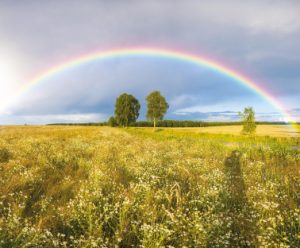The Science of Rainbows

Rainbows are one of nature’s most amazing and beautiful light shows. When sunlight comes down to Earth, the light looks white but is actually made up of different colours that we don’t usually see: red, orange, yellow, green, blue, indigo and violet.
A rainbow is formed when sunlight enters a raindrop. The light bends as it enters the raindrop and then is reflected off the back of the drop. As the reflected light leaves the raindrop towards you it bends again. The amount the light bends depends on the light’s colour. Red light bends the most, orange slightly less and so on. Violet bends the least. This means we only see one specific colour from each raindrop.
All the red light from a rainbow reaches your eyes at one specific angle, all the orange light at a different angle and so on. This is why rainbows appear in an arc with bands of colour.
You can only see a rainbow when the rain is in front of you at a distance and the sun is behind you, low on the horizon. A rainbow is an optical effect and is not a physical object that can be touched.
